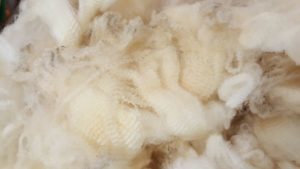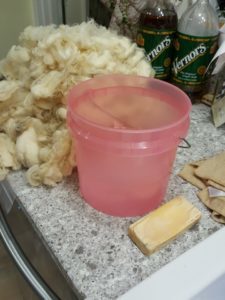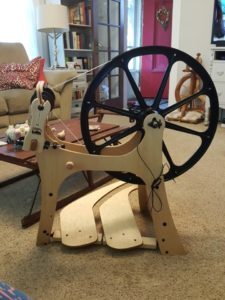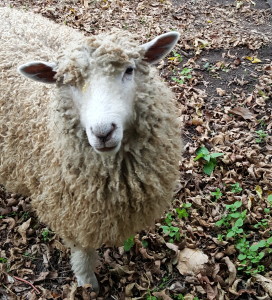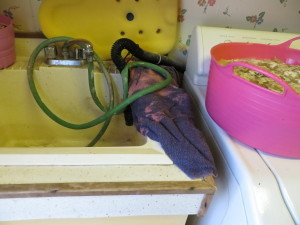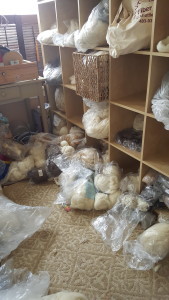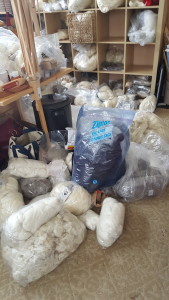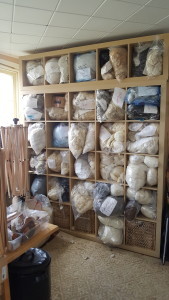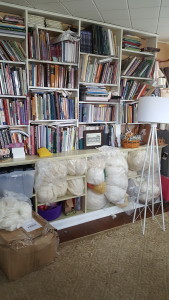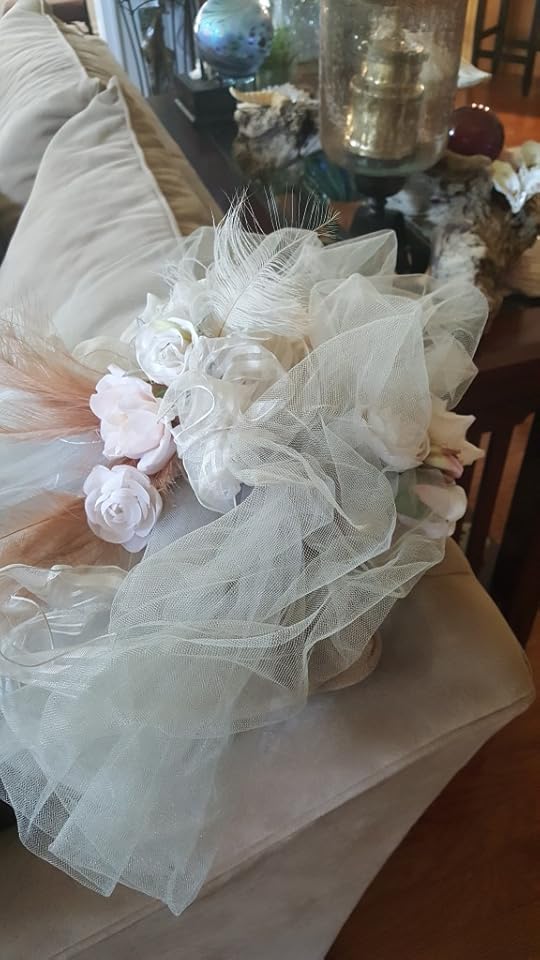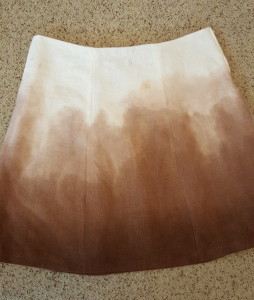Beth Smith's Blog, page 15
January 16, 2017
Weaving Question
I have a question and so I’m going to ask all of you. Any and all help is welcome and appreciated.
I’m getting close to finishing the spinning of the weft for the next skirt which will be from this Blue Faced Leicester top dyed in the Calypso colorway by Amy King of Spunky Eclectic.
This particular skirt will have a 2 ply warp with weft of singles.
All of the warp yarn has been soaked and snapped to finish it. Snapping is the least aggressive finishing method I use and just helps to further even out the twist i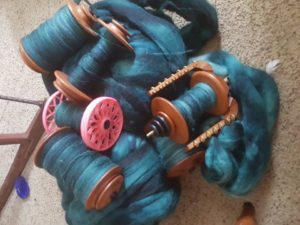 n the skein.
n the skein.
So, here is the question. If it were you, would you wash and block the singles before using them? (By block I mean, I would wind the yarn off onto a pvc niddy noddy and soak and let the skein dry right on the niddy.) Would youwind off the singles and just wash them and not block them? Or would you use them fresh off the bobbin and not worry about washing the yarn until the fabic is being finished?
These are the three ways I can think of but if you have a different idea or way you’ve done it I would be happy to hear from you.
January 9, 2017
The Messy Bobbin
Last Thursday I wrote a post on the Ply Magazine blog about oiling your wheel. I talked about how oiling can fix a multitude of problems and it is my go-to solution – the first thing I try. Well, let me tell you about a different problem I just tackled.
Before Christmas I was spinning and spinning. If you remember, I’m in the midst of spinning a whol lot of yarn for weaving fabric for a skirt. This yarn is a bit finer than the yarn that I made for the last 3 skirts so I need more yardage for the fabric.
Anyway, I’m spinning almost all of the yarn on the Schacht Reeves 30″ Saxony. I love that wheel. And I can spin for hours at a time on it with no problem. Christmas came and I didn’t spin for a couple of weeks because of traveling and things. So last Wednesd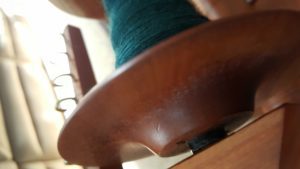 ay I got back at it. I got an empty bobbin, adjusted the tension on the wheel and got to work. But something felt a little off and I found myself adjusting the tension every few minutes and oiling more frequently to try and fix the problem.
ay I got back at it. I got an empty bobbin, adjusted the tension on the wheel and got to work. But something felt a little off and I found myself adjusting the tension every few minutes and oiling more frequently to try and fix the problem.
What if felt like was inconsistent tension. Like there was pull and slack, and pull and slack. Sometimes the pull would be such that it would pull the yarn right away from me and I would have to rejoin. Sometimes it would just slide out of my hand s and sometimes it would snap and break. The slack was adding pig tails to the yarn before it even got to the orifice. I could not figure it out.
Then I remembered that I hadn;t changed the drive band in about 2 months and with the amount of yarn I had spun it was probably time for a change. So, new drive band and back to work.
 Things felt a little better but still not right. By now I had filled my bobbin about 2/3 full and things were getting out of hand. Check out the number of pig tails on there. And I’m doing short forward draw with this yarn so there’s no excuse!
Things felt a little better but still not right. By now I had filled my bobbin about 2/3 full and things were getting out of hand. Check out the number of pig tails on there. And I’m doing short forward draw with this yarn so there’s no excuse!
I was a bit stumped so I continued on for a little bit longer trying to think of all of the things that could have gone wrong. For crying out loud! I had just spun thousands of yards of singles on this wheel with no problem.
And then it hit me. I hadn’t used this bobbin in a while. I found it in a basket behind my chair. Who knows the last time it had been on the wheel.
I changed to a different bobbin that I knew I had spun on just recently and magically everything worked beautifully. The tension is even, the take up is smooth and I’m back to my happy place.
The offending bobbin is put aside and when I fill the current bobbin I think there may be a little bit of surgery. I’m not sure, but I think the bobbin bearings might be a bit tight on the bobbin shaft which will slow the spinning. If this is the case, I will take my round file and file the insid of each bearing just a tiny bit and see if that helps. I’ve done it on many bobbins in the past and it’s an easy way to salvage a bobbin that misbehaves.
If you are going to try this yourself, make sure you don’t file too much at a time. file a little and test it and then file a bit more if necessary. You don’t want to end up with an overly noisy bobbin because it is too loose on the shaft.
September 29, 2016
Washing Wool by the Lock
I did a little experiment this week. Normally for classes I wrap some of the Cormo or other fine wool in tulle and scour them all wrapped up so that the lock structure is preserved. But I have in the past, for a project or samples, just scoured the locks on a bar of Fels Naptha laundry detergent. It’s fast and pretty efficient. But I never actually compared the time it takes to scour lock by lock with the wrapping in tulle method.
So, I weighted out a pound of Cormo fleece and got my buckets and my bar of detergent and got to work so I could time the whole procedure.
The results were that it took about 2.5 hours to scour a pound of Cormo.
I know that that is about and hour slower than wrapping and scouring a pound in my normal class preparation way.
But here’s the thing.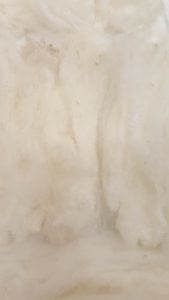 If I were going to scour wool for a fine lace shawl or something else that needs super fine yarn, I would choose the bar of detergent method. It’s super easy. Water temperature isn’t too important and if you are a person that gets upset with a bit of dirt being left in the tips, this method takes care of that.
If I were going to scour wool for a fine lace shawl or something else that needs super fine yarn, I would choose the bar of detergent method. It’s super easy. Water temperature isn’t too important and if you are a person that gets upset with a bit of dirt being left in the tips, this method takes care of that.
So, here’s what I do. I have one bucket of water to wet the lock, one bucket of water to do the first rinse and a bucket or sink to do a second rinse. The water temperature is just warm. I can eaily stick my hand in it.
Wet the lock, rub one end of the lock on the bar of detergent, turn it around and rub the other end of the lock on the bar. Make sure you keep the lock together and intact while you do this and one lock is never more than about the thickness of my thumb or things get harder.
Take the lock and rinse in the second bucket and then the third bucket. Squeeze out as much water as you can and lay the locks on towels to dry.
And that’s it! Super easy.
September 16, 2016
Thinking About Speed
For the last year or so I’ve been thinking about spinning and speed. Until recently I couldn’t find an electric spinner that would consistently give me the speeds I wanted and so I was hunting wheels with traditional treadle drives.
All of this hunting has had me thinking about what exactly makes a spinning wheel to be considered fast and what kinds of things are necessary to make that wheel work well.
So all of this thinking has come together and I’ve been looking at the wheels I own and which wheels I use for what purpose and why. Because of all of this considering and chewing I thought I might start talking about the wheels that I have and why I keep them and how they compare to each other. This will be a little at a time because I have a few wheels I want to talk about.
Today let’s just talk about my newest wheel, the Schacht Flatiron.
Let me tell you right off that I had the opportunity to meet this wheel when it was in its infancy. The wheel was rough, they were working on treadle angles and even still considering some of the hardware for the yet to be named new wheel. Even at this early stage I knew it would be a special wheel and very popular due to some great things that were being built in.
A few of the things that are great about this wheel are:
It is a Saxony style wheel that can be assembled with the flyer on either the right or left depending on our preference.
The drive wheel is 22.5 inches.
The wheel when assembled is only 15 pounds
The wheel uses the standard Schacht flyer and bobbins so if you have another Schacht wheel (other than the Schacht Reeves wheels) your bobbins and flyers will all work together.
The wheel can be used in Double Drive, Scotch Tension and Irish Tension and the transition is very easy.
The wheel is compatible with all of the Schacht whorls which gives a ratio range from 4.6:1 to 26:1 which is a wider range than many other Saxony Wheels on the market.
But let’s get back to the speed question. I have heard several people say that it feels fast. Well, let’s just look at my favorite whorl that works on 4 different Schacht Wheels that I own – the Super High Speed Whorl. We will also talk about drive wheel sizes.
Sidekick, wheel diameter 13.7″ 13:1
Ladybug, wheel diameter 16″ 14.5:1
Matchless, wheel diameter 19.5″ 22:1
Flat Iron, wheel diameter 22.5″ 26:1
With this small chart it’s easy to see how a larger drive wheel can assist with getting more yarn spun. When I talk about speed the first thing I think of is more turns of the flyer per second which will insert twist into the forming yarn more quickly. This allows me to draft and feed the yarn onto the bobbin more quickly resulting in more yards per minute being spun.
When I am spinning samples for an article or a class, speed is not what I’m looking for. I want instead to be able to measure twists per inch and spin with more precision and so I turn to my trusty Matchless and now, hopefully, the Flatiron.
We’ll talk more next time about my search for speed.
September 7, 2016
I Used to Hire Teachers
I had planned a different post for today but there has been a public discussion happening since last Friday. The private discussion has been going on a bit longer…years, I think. The discussion is about getting paid fairly in the fiber arts. It began with the instructors but has spread to those who grow the wool and process the fibers and dye the fibers and sell it all to you.
I’ve waited so long to get into the discussion because many people with prettier words than I have have been saying what I think. I wasn’t sure I had anything to add. But last night I realized I have a unique point of view in this whole thing.
Until 2012 I owned a fiber shop. That means my store didn’t sell yarn (except a little bit of coned yarns for weavers). I was extremely focused on spinning. 1500 square feet of spinning wheels and unspun processed fiber and around 300 fleeces straight off the sheep. I loved it.
About Soon after I bought the shop in 2006 I started to bring in teachers. By the time I closed the store in 2012 I was hiring 6 to 8 instructors every year. The instructors I hired were all nationally/internationally known. I treated them the way I treated the shepherds I bought fleeces from. There was no negotiating of price. I paid their daily rate plus all expenses.
In the beginning, staying at the home of the person who hired you was the norm. I know that because when I would talk to the teachers to find out what they needed, they almost unanimously said they would stay at my house. It wasn’t a problem. They did have a private room and a bath they didn’t have to share because I told the kids to go somewhere else. There were a few teachers who preferred to stay at a hotel and that was fine too.
Now, I’ll tell you something I sort of regret. The first couple of years we did a thing called the Fiber Shop Sleepover. I’m not gonna lie. It was super fun! The students could sleep over at the shop. It was a giant pajama party and almost every time the teacher stayed over too. I was amazed at the number of teachers who said yes.
The reason I regret it is because now that I teach regularly, I understand how grueling it is. I understand how exhausting it can be. In addition, I am a person who needs some alone time every night so I can prepare for the next day. The sleepovers wore me out and I wasn’t even teaching!
Anyway, as I’ve been reading the posts and comments about this whole #fairfiberwage issue there have been several people who have said that the prices are too high and that small shops can’t possibly afford to put these classes on. So I’m going to give you some math. I’ll use the average numbers I would figure on spending if I were hiring myself today. For full transparency, I will tell you I charge $700 per full day (6 hours of instruction) and $400 for a half day class (3 hours of instruction), plus expenses. We’re just going with the $700 for now.
2 full day classes $1400
Airfare or mileage $ 500
Meals for 3 days $ 250 (this allows for one very nice dinner and several average priced meals.)
Baggage Fees $ 60
3 nights Hotel $ 350
Total Expense $2560
Now my shop could fit 15 students after I moved all the stuff out of the way. My goal with these classes was not necessarily to make a lot of money off of the class but I did know that getting students in the shop would increase the sales for the weekend so it was worth it. In addition I had the opportunity to learn new skills from some of the best teachers.
So 15 students total. There were some teachers I didn’t know if I would fill the class and some that I knew would sell out easily. So I based the class prices on that knowledge and honestly the number I chose almost ever time was 8. That’s half. That’s where I priced the class for a break even point.
So, $2560/8=$320 but that’s for the full 2 days. So the class would be $160 per day.
Sometimes I would do the math like that and think that the cost per day was a little high. I rarely liked t charge more than $150 per day so I would reduce the price just a bit to $140. Then I knew I’d better get 9 students.
Now here’s the thing, even 8 years ago when teachers were slightly less expensive I rarely charged less than $125 per day per student. Wanna know why? Because education is important and valuable and I wanted there to be value in the class. I wanted the students to know that the teacher I had hired was worth their time and hard earned money. I hate seeing festivals and shops charging just $50 or $75 for a full day class. In addition, I’m not sure it increases enrollment.
I had people come from all over to attend classes at my shop. Sometimes they would fly in from across the country! I just talked about it a lot on y blog and Twitter and Facebook and my newsletter. My favorite part of having my shop was hosting teachers. That’s the thing I think I miss the most.
And in 6 years of hiring teachers I only lost money on 3 weekends. This included 2008, 2009, and 2010 which were the worst years for the economy in Michigan. I never cancelled any class. Most of the teachers I hired were ones I wanted to take classes from myself and so I had them come so I could learn and so it was still beneficial to everyone.
I know there are some shop owners who will say that their customers won’t pay that much. You never know until you try.
Linky, Linky
Let me give you some links if you haven’t heard about this whole discussion and are interested in catching up.
This one is from Abby Franquemont – Spinner https://medium.com/@abbysyarns/what-d...
This one is from Mary Beth Temple – Crocheter. https://hookedforlifepublishing.wordpress.com/2016/09/03/the-great-teaching-kerfuffle/
This one is from Miriam Felton – Knitter http://www.miriamfelton.com/risk-vs-reward-the-true-costs-of-fiber-teaching/
Here is one from Laura Frye – Weaver. http://laurasloom.blogspot.com/2016/09/labour-day.html?spref=fb
Annie Modesitt – another Knitter. http://www.modeknit.com/2008/03/show-time-teacher-compensation-at.html
Beaders! http://www.beadbiz.org/beads-fibers-and-ideas/whats-the-deal-with-fairfiberwage
Jacey Boggs – Magazine Entrepreneur. http://plymagazine.com/2016/09/fair-fiber-wage-look-side/
And if after that reading you still want more just put #fairfiberwage into the search of Twitter or Facebook and there is a whole bunch more discussion.
July 27, 2016
MIA
Did you ever have a time when everything seems to be crashing down around your ears and you feel like things would be much better if you could just stay home with your spinning wheel and your wool and Netflix?
Have you ever had so many things to worry about that just waking up in the morning feels overwhelming?
I’m not going to go into details about any of it. Some of it isn’t my story to tell but I can say that that is why I’ve been blogging even less than I usually do. I know it’s been a couple of months.
Actually, I just recently got back to spinning and it’s been lovely. I also feel like I’m getting myself back on track and everything is going to be great. I have a few more things to talk about that have to do with fiber and also my fantastic planners so stay tuned.
In the mean time:
May 9, 2016
Wool Scouring – Simple and Mostly Quick
I was looking over past posts about wool scouring and it seems that the posts are kind of scattered and they are not easy to find so I decided it might be a good idea to update things and put all of what I do in one place. This first post will be what I do for almost all of the fleeces I wash. I do have a different method if I want to maintain the lock structure but that’s a diffeerent post. I hope this helps you with your wool scouring questions.
Scouring the way I do allows me to get a six to eight pound fleece done in around 60 to 90 minutes. Becasue of the number of fleeces I wash each year for class materials it is important that I have a method that is efficient and allows for scouring several full fleeces in a day.
Set it Up
First, let me talk about my set up. I do not like to wash an entire fleece all in one container or basin. I don’t use the bath tup or the washing machine for scouring. I find that it can be messy and a bit heavy.
I have a utility sink next to my washing machine. The faucet on that sink has threading on it and I have a length of garden hose attached to it.
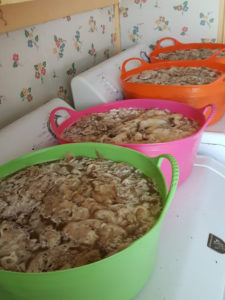 I also have 4 tub trugs. Each will hold up to 2 pounds of wool. You can get these types of tubs from your yarn shop that sells Soak products. Soak calls the ones I have Phil. I’ve been using these same basins for at least 7 years and they have held up beautifully. I believe you can also find these types of tubs at feed supply stores and online. The size I use holds just under 4 gallons of water.
I also have 4 tub trugs. Each will hold up to 2 pounds of wool. You can get these types of tubs from your yarn shop that sells Soak products. Soak calls the ones I have Phil. I’ve been using these same basins for at least 7 years and they have held up beautifully. I believe you can also find these types of tubs at feed supply stores and online. The size I use holds just under 4 gallons of water.
How Hot?
So, I line my four tubs across the washer and dryer top and fill the tubs with water as hot as it comes from the tap. This temperature is around 115 to 120 degrees farenheit. I don’t boil any water and there is no stove top necessary. 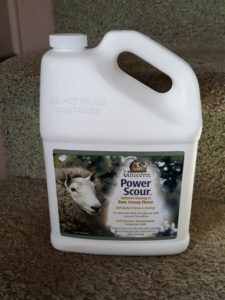
What Detergent?
The reason I can use a lower temperature is because I use Unicorn Power Scour as my wool wash for the dirty stuff. This detergent was specifically formulated to work for wool to get the lanolin out at lower temperatures than is necessary with some other scouring agents. I buy it in the gallon container which lasts me aboout 8 months (maybe 250 pounds of wool) but most people can get by with just the 16 ounce container and it will last a long time.
For around 2 pounds of wool I use a scant 2 tablespoons. The power scour works similarly to 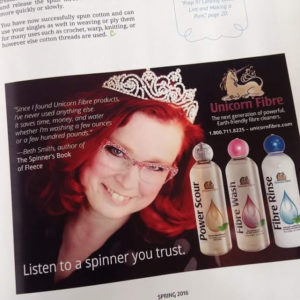 dyeing. What I mean by that is you use the right amount of scour based on the weight of the wool you are going to wash rather than the volume of water you are scouring in. What this means is that even though the scour may feel expensive initially, it actually is very cost effective to use it because you use so little. In addtion there is an energy savings because no water needs to be heated on the stove. Fnally, there is a water savings because it is not very sudsy and so less rinsing is required. You can tell I love the stuff because they put my photo in their last advertisement in both Ply Magazine and Spin Off!
dyeing. What I mean by that is you use the right amount of scour based on the weight of the wool you are going to wash rather than the volume of water you are scouring in. What this means is that even though the scour may feel expensive initially, it actually is very cost effective to use it because you use so little. In addtion there is an energy savings because no water needs to be heated on the stove. Fnally, there is a water savings because it is not very sudsy and so less rinsing is required. You can tell I love the stuff because they put my photo in their last advertisement in both Ply Magazine and Spin Off!
I have done all of the experimenting and this works super well for me. But I understand that there are different water issues all over and so I would encourage you to do your own experimenting,
Ok back to the scouring.
Soak it
So I’ve filled the conatiners with hot water and I’ve added the scouring detergent. Now I add the wool. Some wools are puffier than others and so the basin may only take 1.5 pounds. The down type breeds are notoriously fluffy. You want to have a bit of room in the tub so the dirt can get away from the fleece. It’s hard for me to explain how much room to leave but you’ll know if you are overfilling.
At this point I get out my paint stirrer. I keep several of them and my family knows not to throw them away. Paint stirrers are the way I push the wool under the water. They are free and easy to get at the hardware store.
As you push the wool into the water you will see that the water level is dropping because wool soaks up the water. At this point I add more water to the bins. I try to aim the hose at the edge of the bucket but I’ve never had a problem with felting so don’t worry about doing this. You need the water though. I fill the bin to within a half inch of the top.
Now walk away for about 15 minutes. I’ve found that 15 minutes works well. You don’t want to let the water cool. I’ve done that and the lanolin resettles and it’s difficult to get it to come off later.
After 15 minutes or so, I take a bucket to the sink and dump it out. If I dump it toward my body agains the side of the sink, the wool stays in as the water drains out. This way I don’t lose wool down the drain.
I put the bucket back in place and refill it with hot water and this time only half the amount of Power Scour I used in the first wash. 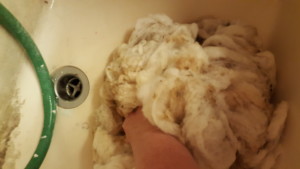
Before I put the wool into the clear water I squeeze out as much water as I can.
I do this with all four buckets one by one.
Second Soak
So the wool is back in the clean water with half the amount of Power Scour that was in the first wash. And it soaks again for 15 minutes.
Third Soak
Repeat the last process but this time, for most fleeces, I don’t add any detergent to the water. I will do one more soak with detergent if I am scouring a fleece that is particularly greasy. Usually this would be a Cormo or Merino fleece. Most others will only need 2 scouring soaks. I don’t know how to tell you how to decide. but I wuld suggest that if you are going to scouring Merino or Cormo, just do the third wash and you won’t be sorry.
If it is any other breed then this third soak is just clear water with no scour added. 15 minutes one more time.
Fourth Soak
This time the wool only sits for a few minutes. This one is just to get the last bit of detergent out if there is any hanging around.
I would like to say that at this point, often, the water is not completely clear that is coming from the fleece. There may still be some dirt left. Obviously not as much as we started with but there is still some there. I don’t worry about that. My main goal in scoouring is to remove the lanolin and get the major part of the dirt out. remember that after you spin the wool you will soak and rinse the yarn and then after you use the yarn there is another opportunity to soak the wool. Over scouring jsut results in dried out, crunchy fiber that is not pleasant to touch.
In addition, when I am scouring wools that have less lanolin, they have a tendency to get dried out and crunchy no matter what so I often will add a bit of Unicorn Fibre Rinse in the last rinse to guard against that unpleasant feeling. This fiber rinse also cuts down on static during processing later.
Spin it Out
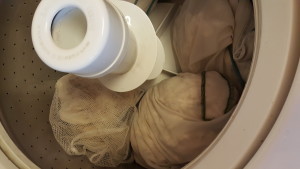 This time when I empty the water I take the flleece and put it in lingerie bags. I take those bags and put them into my top loading washing machine to spin out as much water as possible. For my washer, if I use the spin cycle for whites, no water sprays during the spinning. You want to avoid spraying water and if necessary turn the water off that goes to the washing machine.
This time when I empty the water I take the flleece and put it in lingerie bags. I take those bags and put them into my top loading washing machine to spin out as much water as possible. For my washer, if I use the spin cycle for whites, no water sprays during the spinning. You want to avoid spraying water and if necessary turn the water off that goes to the washing machine.
I don’t have any advice about if you have a front loading machine. Many of the newer front loaders do some kind of tossing the contents around a bit and I am not sure how this will affect your wet fleece.
If you don’t have a washer you can use for spinning the water out then just use a few towels. Up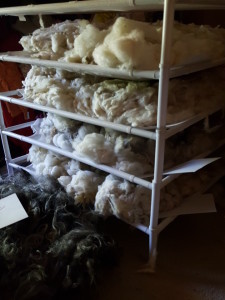 until about 2 years ago I didn’t spin out in the washer. What I did instead was to take the wool and squeeze out as much water as I could with my hands. Then I took that wool and put it on the floor on top of a towel, placed another towel on top and stepped on it to squeeze out as much water as possible.
until about 2 years ago I didn’t spin out in the washer. What I did instead was to take the wool and squeeze out as much water as I could with my hands. Then I took that wool and put it on the floor on top of a towel, placed another towel on top and stepped on it to squeeze out as much water as possible.
Let it Dry
Finally, the wool has to dry. I use sweater dryers that are stacked on top of each other. And I oftern place a fan in front of the sweater dryers. If I run out of space on the sweater dryers then there are fleeces just 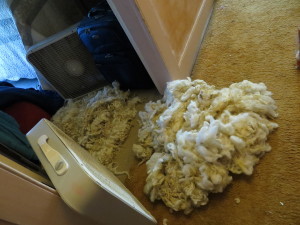 laying on the floor on top of towels.
laying on the floor on top of towels.
One Final Thing
I’ve been scouring this way for more than 10 years, and the last 3 years I’ve benn scouring around 300 pounds of wool each year. We have never had a clogged pipe due to the lanolin going down the drain. We are on city sewer so I am not sure how people with septic systems would be affected but I do know that Unicorn Power Scour has passed rigorous testing methods by city systems. It is biodegradeable and when certain mills were working on getting permits for opening, Power Scour passed the water tests better than any of the other wool washes that were being tested.
Ok, off to get some scouring done.
April 15, 2016
Something Funny
So for the last 4 days I’ve been thinking about what I need to do to get ready for my next deadlines and projects and classes. It’s actually not that much and I could have had it done in 2 days if I just focused and got to work. But I didn’t.
For the last 4 weeks I’ve been doing the bare minimum of work or anything craftual because of other things happening in my life and spending three weeks with my parents in Penssylvania. And i think that’s what my problem is right now.
I realized something this morning. No matter what I’m supposed to be doing, if I don’t feel like I have time to work on a couple of things I want to do I get a bit paralized.
Next Wednesday I leave for Kansas City to teach at Plyaway. It’s going to be great! (still some spaces available) And I’ve already shipped the fiber for my classes but there are some little bits of things that need to be done – like handouts and other small classroom helps. Also, I have a special skirt that is cut out but needs to be sewn specially for this retreat. There are three breeds I don’t have samples for but should. And I need to pack the tools I take along. You know, combs, hand cards, flicks that I lend to all of those who don’t own all of the tools, as well as my spinning wheel.
See? 2 days and I could be done.
Know what I’d rather do? spin the Blue Faced Leicester for my next skirt. And so I’ve been doing none of it.
Know what I did instead? I asked Chelsea to come over and we inventoried the clean and raw fleeces as well as the mill prepared fiber I have on hand. We also cleaned up my studio. I have some before and after photos for you.
Before
After
See? Better. But not the immediate needs. I do feel better in there though and now I know what I’m missing for my June classes…
I hear you yelling at me. I could just take an hour or two each day to spin for the thing I want to do and then maybe I could focus on my commitments. Yeah, well, I just realised this morning that that might work.
Yep. I’m slow.
Alright, I’m going. To do the things that I should do to get ready. And maybe spin a little of the Blue Faced Leicester.
March 30, 2016
A Feathered Hat
I’ve had some inquiries concerning my recent whereabouts.
I’m in Pennsylvania at my parent’s house. I’ve been here for about 3 weeks. I’m actually going to drive home on Friday. That’s good. I miss my kids and my darling. I came to PA to help out for as loing as I could. My youngest sister will be taking my place when I leave.
I need to go home because we have a short vacation planned for the end of next week and also Plyaway is coming quickly and even thouigh I packed up all of my materials before I left, I need to ship the boxes and get some other bits ready to go.
While I’ve been here we’ve gone through some family pictures and joked and laughed a lot. I also found my wedding hat and the jacket to my wedding dress. The rest of the dress is at home in my closet.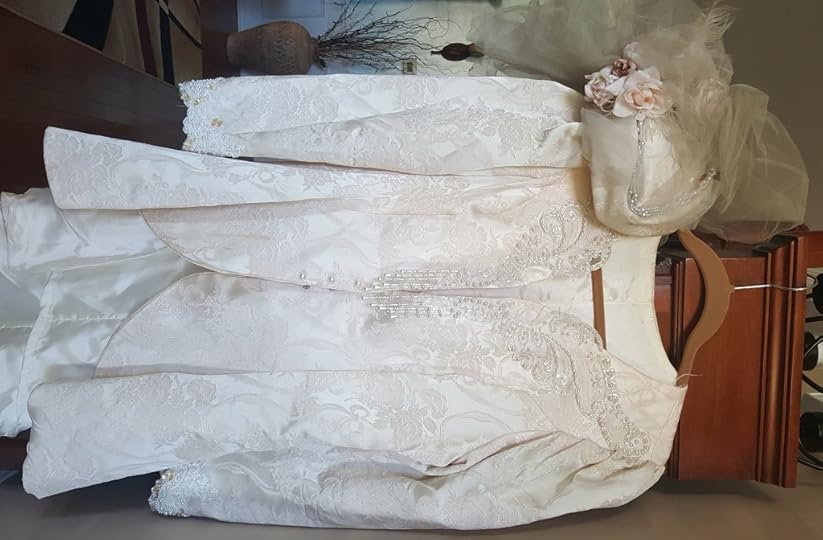
Your eyes are not deceiving you. It is pink. Victorian-like. When I got married my parents owned a victorian mansion that they ran as a bed and breakfast. I used to work there. We had the wedding out in the back yard with a tent and all the things. It was the best wedding I’ve ever been to.
My mom made my dress, the bridesmaids dresses, did all of the flowers and most of the food. Here’s her picture:
The dress story is kind of funny. I had been to several dress shops and tried things on but nothing was right. We were sitting together at a bridal show waiting for the dress fashion show to begin and I saw the lghtbulb appear over her head. I quickly got her some paper and a pencil and she sketched my dress as well as a hat to match. We didn’t even see any of the dresses before she was done sketching.
After that we went to Philadelphia to choose the fabric and this pink brocade was the perfect thing for the dress.
I had brocade pumps dyed to match…I wonder where they got to.
This beaded lace at the neckline is still beautiful to me.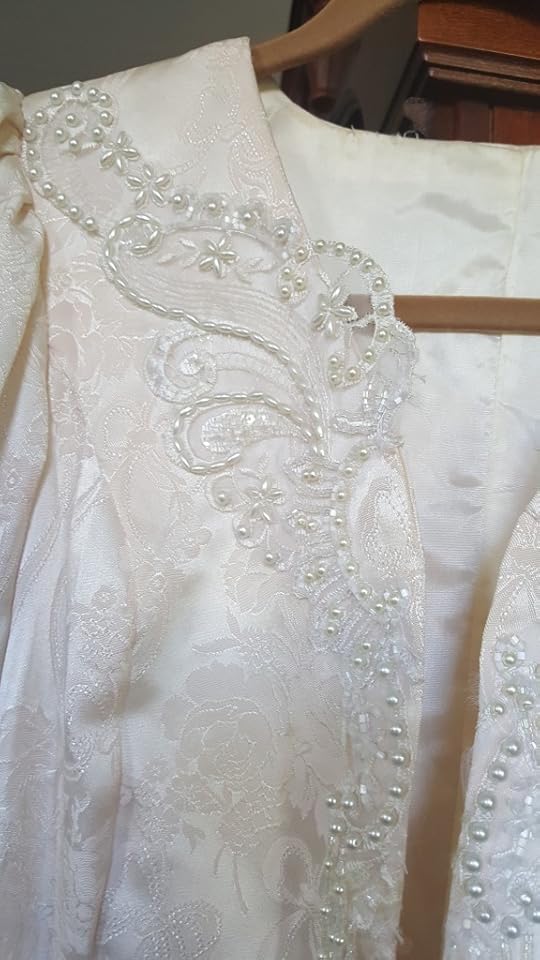
I still love the dress and the hat.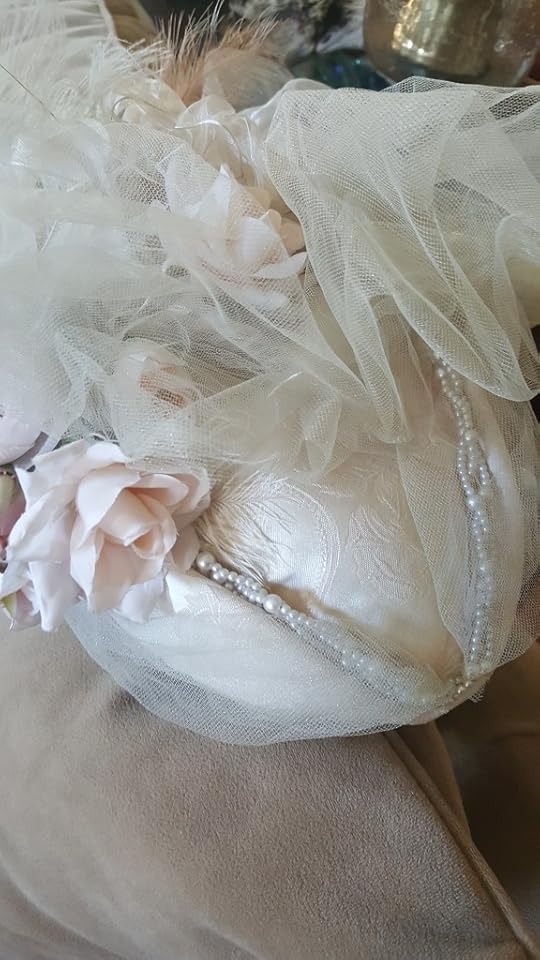
So, the question of the day is this: without taking the whole thing apart, is there a way to clean the tulle on the hat? It’s very grey and dusty.
I’ll be taking all of this home with me on Friday.
March 2, 2016
A Skirt on the Rigid Heddle Loom.
This was a long term project. The yarn is from Imperial Ranch Columbia Roving. Spun on my Schacht Reeves 30″ Saxony. There is an eight part blog series on the Schacht blog about the whole thing along with a project that Jillian Moreno did. I thought I might put all of the links right here so it’s easier to follow.

